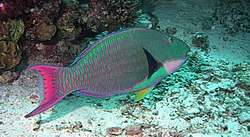Cetoscarus bicolor
Cetoscarus bicolor, also known as the bicolour parrotfish or bumphead parrotfish,[1] is a species of fish belonging to the family Scaridae. It is found only in the Red Sea.
| Cetoscarus bicolor | |
|---|---|
 | |
_-_%D1%81%D0%B0%D0%BC%D0%BA%D0%B0.DSCF8285%D0%92%D0%95.jpg) | |
| Terminal phase above, initial phase below | |
| Scientific classification | |
| Kingdom: | Animalia |
| Phylum: | Chordata |
| Class: | Actinopterygii |
| Order: | Labriformes |
| Family: | Scaridae |
| Genus: | Cetoscarus |
| Species: | C. bicolor |
| Binomial name | |
| Cetoscarus bicolor (Rüppell, 1829) | |
| Synonyms[2] | |
| |
Distribution and habitat
While this species is restricted to the Red Sea, there is a similar species which is widespread in the Indo-Pacific is Cetoscarus ocellatus, also sometimes called the bicolour parrotfish.[3][4] These species were formally classified as one, the only in the genus Cetoscarus, but there are major molecular and morphological differences between the two.[1] C. bicolor is associated with coral reefs. It usually can be found in lagoons and seaward reefs at depths between 1 and 30 m (3 ft 3 in and 98 ft 5 in).[3] Small juveniles are usually found among dense coral and in algae-rich habitats.[2]
Description
It is among the largest parrotfishes, growing to a standard length of up to 50 cm (20 in).[2] As in many of its relatives, it is a sequential hermaphrodite, starting as female (known as the initial phase) and then changing to male (the terminal phase). The initial phase is dark brown with a large cream patch on the upper part of the body. The terminal phase is very colourful, overall green with pink spotting to the body and edging to the fins. Juveniles are white with a black spot on the dorsal fin and an orange band through the eye.
Behaviour
As in other parrotfish species, males are territorial. During its lifetime, this fish changes sex twice and very large females change sex to become brightly coloured males. This parrotfish mainly feeds on algae.[2]
References
| Wikimedia Commons has media related to Cetoscarus bicolor. |
| Wikispecies has information related to Cetoscarus bicolor |
- Choat, J.H.; Russell, B.; Clements, K.D.; et al. (2012). "Cetoscarus bicolor". IUCN Red List of Threatened Species. 2012: e.T190690A17793737. doi:10.2305/IUCN.UK.2012.RLTS.T190690A17793737.en. Retrieved 8 February 2020.
- Froese, Rainer and Pauly, Daniel, eds. (2019). "Cetoscarus bicolor" in FishBase. March 2019 version.
- "Bicolor Parrotfish - Cetoscarus bicolor - Details - Encyclopedia of Life".
- Randall, J. E. (2005). Reef and Shore Fishes of the South Pacific. University of Hawi'i Press. ISBN 0824826981
External links
- Photos of Cetoscarus bicolor on Sealife Collection
